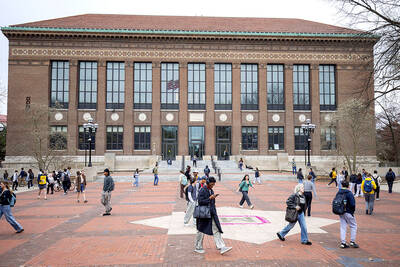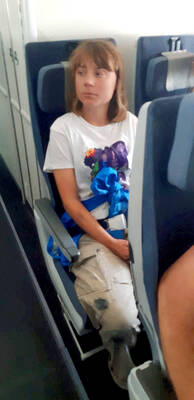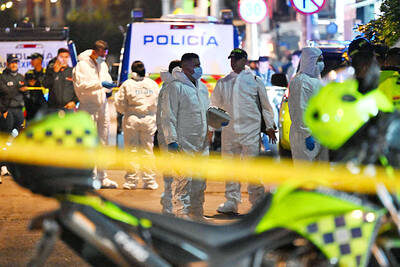Japanese scientists are to explore the center of the Earth. Using a giant drill ship launched next month, the researchers aim to be the first to punch a hole through the rocky crust that covers the planet and to reach the mantle.
The team wants to retrieve samples from the mantle, six miles down, to learn more about what triggers undersea earthquakes, such as the one off Sumatra that caused the devastating Asian tsunami on Dec. 26 last year. They hope to study the deep rocks and mud for records of past climate change and to see if the deepest regions of Earth could harbor life.
"One of the main purposes of doing this is finding deep bacteria within the ocean crust and upper mantle. We believe there has to be life there. It's the same mission as searching for life on Mars," said Asahiko Taira, director general of the Center for Deep Earth Exploration in Yokohama.
Rocks in the upper mantle produce compounds essential for life when they react with sea water.
"This is a system which we believe created early life. There may be a chance that we can catch the origin of life still taking place today," Taira said.
The 57,500-tonne drill ship Chikyu ("Earth") is being prepared in the port of Nagasaki. Two-thirds the length of the Titanic, it is fitted with technology borrowed from the oil industry that will allow it to bore through 7,000m of crust below the sea bed while floating in 2,500m of water -- requiring a drill pipe 25 times the height of the Empire State building.
The deepest hole drilled through the sea bed so far reached 2,111m.
After final sea trials this year, the scientists will set sail for the deep Pacific where the Earth's crust is thinnest. Drilling is expected to begin next year.
It could take more than a year to drive through miles of crust and reach the mantle, so the ship is fitted with six rotating thrusters controlled by GPS satellites to keep it directly over the hole.
The drill is surrounded by a sleeve that contains a shock-absorbing chemical mud, and a blowout valve will protect it should the team strike oil or superheated rock in the crust.
The project is part of an international effort called the Integrated Ocean Drilling Program which also involves the US and Europe.
Shinichi Kuramoto, one of the Yokohama team, said Chikyu's main objective is to retrieve mantle samples for analysis.
"Humans have brought back lunar rocks to understand the universe, yet we have never reached the mantle which accounts for most of Earth," Kuramoto said.
Previously undiscovered bacteria that can survive the anticipated 100?C temperatures of the upper mantle could be useful on the surface. Heatproof enzymes isolated from bugs brought back by earlier Japanese drill missions are now used in washing powders.
Cores of rock and sediment from the so-called "earthquake nest" where the mantle meets the crust could also help geologists understand seismic events, and to perhaps give more warning.
"We can estimate how frequently marine sliding or earthquakes occur from learning the history of Earth but we still don't know when they will occur in the future," Kuramoto said.
Sensors placed in the borehole could detect changes in strain, tilt and pressure in the ground miles below the surface.
"That will be a great advantage in giving us a few days or hours warning before something happens," Kuramoto said.

Brazil, the world’s largest Roman Catholic country, saw its Catholic population decline further in 2022, while evangelical Christians and those with no religion continued to rise, census data released on Friday by the Brazilian Institute of Geography and Statistics (IBGE) showed. The census indicated that Brazil had 100.2 million Roman Catholics in 2022, accounting for 56.7 percent of the population, down from 65.1 percent or 105.4 million recorded in the 2010 census. Meanwhile, the share of evangelical Christians rose to 26.9 percent last year, up from 21.6 percent in 2010, adding 12 million followers to reach 47.4 million — the highest figure

A Chinese scientist was arrested while arriving in the US at Detroit airport, the second case in days involving the alleged smuggling of biological material, authorities said on Monday. The scientist is accused of shipping biological material months ago to staff at a laboratory at the University of Michigan. The FBI, in a court filing, described it as material related to certain worms and requires a government permit. “The guidelines for importing biological materials into the US for research purposes are stringent, but clear, and actions like this undermine the legitimate work of other visiting scholars,” said John Nowak, who leads field

Swedish campaigner Greta Thunberg was deported from Israel yesterday, the Israeli Ministry of Foreign Affairs said, the day after the Israeli navy prevented her and a group of fellow pro-Palestinian activists from sailing to Gaza. Thunberg, 22, was put on a flight to France, the ministry said, adding that she would travel on to Sweden from there. Three other people who had been aboard the charity vessel also agreed to immediate repatriation. Eight other crew members are contesting their deportation order, Israeli rights group Adalah, which advised them, said in a statement. They are being held at a detention center ahead of a

‘THE RED LINE’: Colombian President Gustavo Petro promised a thorough probe into the attack on the senator, who had announced his presidential bid in March Colombian Senator Miguel Uribe Turbay, a possible candidate in the country’s presidential election next year, was shot and wounded at a campaign rally in Bogota on Saturday, authorities said. His conservative Democratic Center party released a statement calling it “an unacceptable act of violence.” The attack took place in a park in the Fontibon neighborhood when armed assailants shot him from behind, said the right-wing Democratic Center, which was the party of former Colombian president Alvaro Uribe. The men are not related. Images circulating on social media showed Uribe Turbay, 39, covered in blood being held by several people. The Santa Fe Foundation